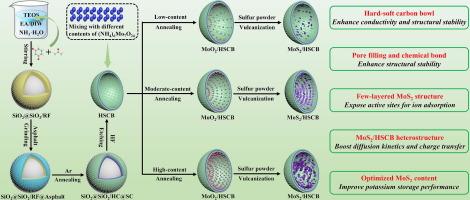当前位置:
X-MOL 学术
›
Chem. Eng. J.
›
论文详情
Our official English website, www.x-mol.net, welcomes your
feedback! (Note: you will need to create a separate account there.)
Optimized few-layer MoS2 confined in carbon bowls via pore filling and chemical bond enabling fast kinetics for high-rate potassium storage
Chemical Engineering Journal ( IF 13.3 ) Pub Date : 2024-11-19 , DOI: 10.1016/j.cej.2024.157821 Lei Yang, Xinyu Wang, Chunliu Zhu, Haozhi Wang, Jing Shi, Jingwei Chen, Weiqian Tian, Yue Zhu, Minghua Huang, Jingyi Wu, Huanlei Wang
Chemical Engineering Journal ( IF 13.3 ) Pub Date : 2024-11-19 , DOI: 10.1016/j.cej.2024.157821 Lei Yang, Xinyu Wang, Chunliu Zhu, Haozhi Wang, Jing Shi, Jingwei Chen, Weiqian Tian, Yue Zhu, Minghua Huang, Jingyi Wu, Huanlei Wang

|
Molybdenum sulfide (MoS2) is a prospective anode material for potassium-ion batteries, owing to its large interlayer spacing and superior theoretical capacity. Nevertheless, its practical application is hindered by sluggish kinetics and inferior structural stability, which limit its potassium storage performance. Herein, we employ hollow hard-soft carbon bowls (HSCB), consisting of soft carbon uniformly coated on hard carbon bowls, as nanoreactors to confine few-layered MoS2 nanosheets. The mesoporous carbon shells of HSCB enhance electrolyte penetration and enable rapid charge transfer and robust structural protection, while the mechanical coupling induced by pore filling, alongside the exist of C S
S Mo chemical bonds, further reinforces the structural integrity of MoS2. Additionally, the creation of few-layered MoS2 structures and MoS2/carbon heterostructures promotes efficient K-ion adsorption and diffusion. Notably, there is a strong linear relationship between MoS2 content and electrochemical performance, including initial Coulomb efficiency, rate performance, and reaction kinetics. Consequently, the optimized MoS2/HSCB anode demonstrating a superior reversible capacity of 630 mAh g−1 at 0.1 A g−1, an exceptional rate capacity of 251 mAh g−1 at 10 A g−1, and excellent cycling stability, retaining 369 mAh g−1 at 0.5 A g−1 after 700 cycles. Remarkably, a potassium-ion hybrid capacitor assembled with MoS2/HSCB anode achieves superior energy/power densities of 122 Wh kg−1/11266 W kg−1, along with splendid capacity retention of 89.5 % after 5000 cycles. This work not only offers an innovative approach for the structural engineering of high-performance sulfide-based composite materials but also elucidates the impact of sulfide content on electrochemical performance.
Mo chemical bonds, further reinforces the structural integrity of MoS2. Additionally, the creation of few-layered MoS2 structures and MoS2/carbon heterostructures promotes efficient K-ion adsorption and diffusion. Notably, there is a strong linear relationship between MoS2 content and electrochemical performance, including initial Coulomb efficiency, rate performance, and reaction kinetics. Consequently, the optimized MoS2/HSCB anode demonstrating a superior reversible capacity of 630 mAh g−1 at 0.1 A g−1, an exceptional rate capacity of 251 mAh g−1 at 10 A g−1, and excellent cycling stability, retaining 369 mAh g−1 at 0.5 A g−1 after 700 cycles. Remarkably, a potassium-ion hybrid capacitor assembled with MoS2/HSCB anode achieves superior energy/power densities of 122 Wh kg−1/11266 W kg−1, along with splendid capacity retention of 89.5 % after 5000 cycles. This work not only offers an innovative approach for the structural engineering of high-performance sulfide-based composite materials but also elucidates the impact of sulfide content on electrochemical performance.
中文翻译:

优化的几层 MoS2 通过孔隙填充和化学键限制在碳碗中,可实现高速钾储存的快速动力学
硫化钼 (MoS2) 由于其层间距大和卓越的理论容量,是一种有前景的钾离子电池负极材料。然而,其实际应用受到动力学缓慢和结构稳定性差的阻碍,限制了其储钾性能。在此,我们采用空心硬软碳碗 (HSCB),由均匀涂布在硬碳碗上的软碳组成,作为纳米反应器来限制少层 MoS2 纳米片。HSCB 的介孔碳壳增强了电解质的渗透性,实现了快速电荷转移和强大的结构保护,而孔隙填充引起的机械耦合,以及 C S
S  Mo 化学键的存在,进一步增强了 MoS2 的结构完整性。此外,少层 MoS2 结构和 MoS2/碳异质结构的产生促进了 K 离子的高效吸附和扩散。值得注意的是,MoS2 含量与电化学性能之间存在很强的线性关系,包括初始库仑效率、倍率性能和反应动力学。因此,优化的 MoS2/HSCB 阳极在 0.1 A g-1 时表现出 630 mAh g-1 的卓越可逆容量,在 10 A g-1 时具有 251 mAh g-1 的出色倍率容量,以及出色的循环稳定性,在 700 次循环后在 0.5 A g-1 下保持 369 mAh g-1。值得注意的是,与 MoS2/HSCB 阳极组装的钾离子混合电容器实现了 122 Wh kg-1/11266 W kg-1 的卓越能量/功率密度,以及 89 的出色容量保持率。5 次循环后 5000 %。这项工作不仅为高性能硫化物基复合材料的结构工程提供了一种创新方法,而且还阐明了硫化物含量对电化学性能的影响。
Mo 化学键的存在,进一步增强了 MoS2 的结构完整性。此外,少层 MoS2 结构和 MoS2/碳异质结构的产生促进了 K 离子的高效吸附和扩散。值得注意的是,MoS2 含量与电化学性能之间存在很强的线性关系,包括初始库仑效率、倍率性能和反应动力学。因此,优化的 MoS2/HSCB 阳极在 0.1 A g-1 时表现出 630 mAh g-1 的卓越可逆容量,在 10 A g-1 时具有 251 mAh g-1 的出色倍率容量,以及出色的循环稳定性,在 700 次循环后在 0.5 A g-1 下保持 369 mAh g-1。值得注意的是,与 MoS2/HSCB 阳极组装的钾离子混合电容器实现了 122 Wh kg-1/11266 W kg-1 的卓越能量/功率密度,以及 89 的出色容量保持率。5 次循环后 5000 %。这项工作不仅为高性能硫化物基复合材料的结构工程提供了一种创新方法,而且还阐明了硫化物含量对电化学性能的影响。
更新日期:2024-11-20
 S
S Mo chemical bonds, further reinforces the structural integrity of MoS2. Additionally, the creation of few-layered MoS2 structures and MoS2/carbon heterostructures promotes efficient K-ion adsorption and diffusion. Notably, there is a strong linear relationship between MoS2 content and electrochemical performance, including initial Coulomb efficiency, rate performance, and reaction kinetics. Consequently, the optimized MoS2/HSCB anode demonstrating a superior reversible capacity of 630 mAh g−1 at 0.1 A g−1, an exceptional rate capacity of 251 mAh g−1 at 10 A g−1, and excellent cycling stability, retaining 369 mAh g−1 at 0.5 A g−1 after 700 cycles. Remarkably, a potassium-ion hybrid capacitor assembled with MoS2/HSCB anode achieves superior energy/power densities of 122 Wh kg−1/11266 W kg−1, along with splendid capacity retention of 89.5 % after 5000 cycles. This work not only offers an innovative approach for the structural engineering of high-performance sulfide-based composite materials but also elucidates the impact of sulfide content on electrochemical performance.
Mo chemical bonds, further reinforces the structural integrity of MoS2. Additionally, the creation of few-layered MoS2 structures and MoS2/carbon heterostructures promotes efficient K-ion adsorption and diffusion. Notably, there is a strong linear relationship between MoS2 content and electrochemical performance, including initial Coulomb efficiency, rate performance, and reaction kinetics. Consequently, the optimized MoS2/HSCB anode demonstrating a superior reversible capacity of 630 mAh g−1 at 0.1 A g−1, an exceptional rate capacity of 251 mAh g−1 at 10 A g−1, and excellent cycling stability, retaining 369 mAh g−1 at 0.5 A g−1 after 700 cycles. Remarkably, a potassium-ion hybrid capacitor assembled with MoS2/HSCB anode achieves superior energy/power densities of 122 Wh kg−1/11266 W kg−1, along with splendid capacity retention of 89.5 % after 5000 cycles. This work not only offers an innovative approach for the structural engineering of high-performance sulfide-based composite materials but also elucidates the impact of sulfide content on electrochemical performance.
中文翻译:

优化的几层 MoS2 通过孔隙填充和化学键限制在碳碗中,可实现高速钾储存的快速动力学
硫化钼 (MoS2) 由于其层间距大和卓越的理论容量,是一种有前景的钾离子电池负极材料。然而,其实际应用受到动力学缓慢和结构稳定性差的阻碍,限制了其储钾性能。在此,我们采用空心硬软碳碗 (HSCB),由均匀涂布在硬碳碗上的软碳组成,作为纳米反应器来限制少层 MoS2 纳米片。HSCB 的介孔碳壳增强了电解质的渗透性,实现了快速电荷转移和强大的结构保护,而孔隙填充引起的机械耦合,以及 C


















































 京公网安备 11010802027423号
京公网安备 11010802027423号